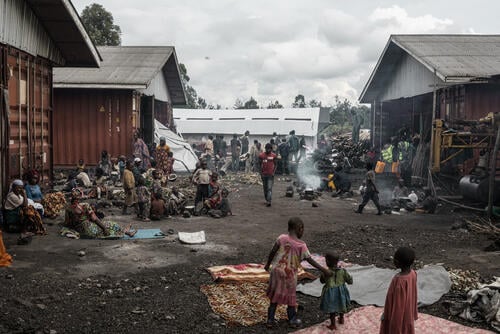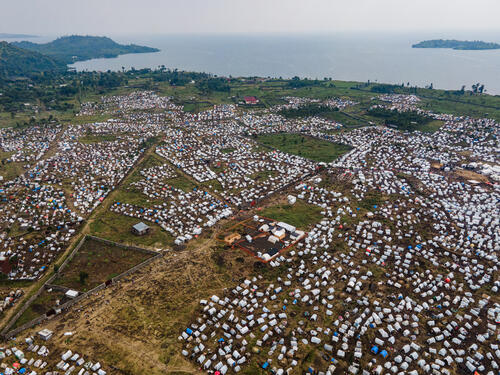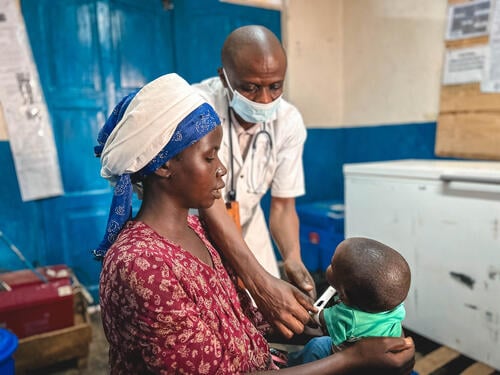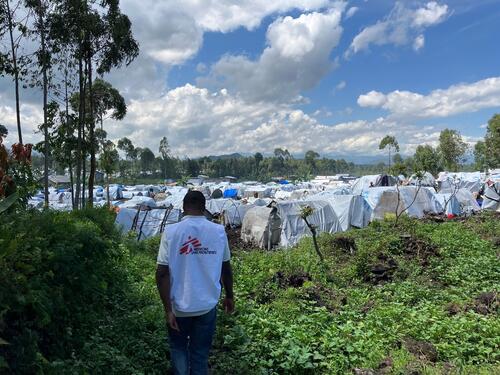- MSF teams have noted an inadequate level of aid for people living in desperate conditions in North Kivu, Democratic Republic of Congo, at risk of malnutrition and deadly diseases.
- Data collected by our teams indicate that malnutrition rates are well above emergency thresholds in North Kivu.
- It is vital that UN agencies’ pledge for support translates into actionable assistance and protection for displaced people.
Some 600,000 displaced people are living in desperate conditions, with inadequate access to food and exposed to violence in camps around Goma, in the North Kivu region of Democratic Republic of Congo (DRC). Médecins Sans Frontières (MSF) teams have witnessed alarming rates of malnutrition and mortality in some of the camps.
UN agencies recently announced they would be stepping up their efforts to meet the needs of people in the east of the country. These intentions urgently need to be translated into additional assistance and protection in line with displaced people’s needs.
For several months now, we have noted the slow pace and inadequate level of aid provided to people who have fled their homes due to the resurgence of the M23 armed group and the fighting that has ensued.

Despite a certain increase in humanitarian aid in the past weeks, the approximately 600,000 people currently living in several sites surrounding Goma continue to lack assistance, particularly concerning food and shelter, which remain insufficient in quantity and quality.
On Friday 16 June, the UN announced it will be raising the severity of the crisis to the highest level on the scale of UN organisations. This is a positive sign, but this awareness urgently needs to be translated into a significant, rapid and tangible increase in the aid provided to people in the camps.
A retrospective mortality survey carried out by MSF in April in Rusayo, Shabindu and Don Bosco camps, covering the period from January to April, revealed alarming mortality rates among children under five.
In Rusayo, where there are estimated to be between 85,000 and 100,000 people, more than three children died on average every day (1.6 deaths per 10,000 children per day) from various causes during this period.
In Elohim, where 4,000 people resided at the time of a rapid nutritional survey carried out at the end of May, our teams collected data that revealed malnutrition rates well above emergency thresholds, with rates of severe acute malnutrition reaching 4.9 per cent among children under five.
This catastrophic situation is even more incomprehensible given the camps proximity to the major city of Goma, where aid could easily be distributed.Dr Guyguy Manangama, head of emergency programmes for MSF
In May, our teams in Elohim camp treated one in four children for malnutrition. In this same camp, many displaced people report having received no food assistance since their arrival, in some cases as long ago as January.
At other camps, such as Rusayo and Shabindu, some food has been distributed, but not to all residents. This alarming situation is compounded by several risk factors such as cases of measles and cholera in the camp.
The shortage of food is also impacting the health of adults, especially women, who often have to leave the camps to look for food or firewood, exposing themselves to the risk of violence, particularly sexual violence.
In early May, we raised the alarm over the high number of women treated by our teams for sexual violence: in two weeks, 674 women from Bulengo, Lushagala, Kanyaruchinya, Elohim, Munigi and Rusayo camps reported having experienced sexual violence.
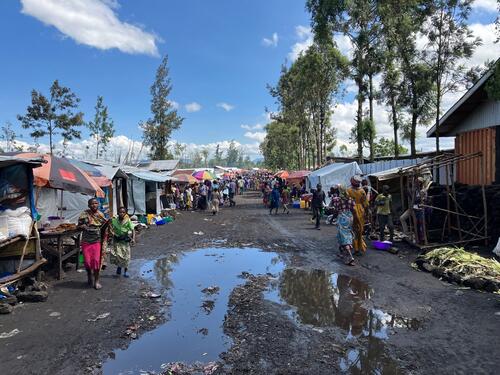
Currently, an average of 40 women a day report being a victim of sexual violence in these same sites. Although humanitarian organisations appear to be aware of the gravity of the situation, aid and protection measures are currently supporting only a small proportion of sexual violence survivors. The safety of civilians inside and outside the camps must be urgently ensured.
“This catastrophic situation is even more incomprehensible given the camps proximity to the major city of Goma, where aid could easily be distributed,” says Dr Guyguy Manangama, head of emergency programmes for MSF.
“Relief activities are being developed here and there, but without any coordination or overview of the situation in the camps,” he says.
The scale of mobilisation from the aid system is far from sufficient and far too slow.Dr Guyguy Manangama, head of emergency programmes for MSF
“The scale of mobilisation from the aid system is far from sufficient and far too slow. There is also a blatant lack of visibility and information on the aid provided, and on the number of people in need of support – information which is nonetheless necessary for the proper coordination of aid organisations,” says Dr Manangama.
Many of the displaced people arrived in the camps after experiencing serious episodes of violence. MSF’s retrospective mortality survey in Rusayo, Shabindu and Don Bosco camps showed that violence was the main cause of death among men (up to 40 per cent in some camps), with two deaths per 10,000 people per day, between January and the end of April.
These deadly episodes were mostly experienced in the victims’ place of origin or on their journey to the Goma area. This is twice the emergency threshold of one death per 10,000 people per day.
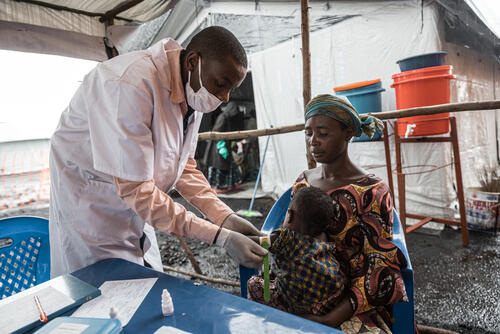
“The scale and duration of displacement is historic, even for eastern DRC,” says Dr Manangama. “This gives us an idea of the response that is needed. Yet hundreds of thousands of people continue to be largely neglected by the aid community, despite the growing awareness of the humanitarian system.”
During the first months of the crisis in 2022, the humanitarian response, including that of MSF, was too slow to get underway. Since then, we have continued to implement interventions to support the people here. Today, we have mobilised a further €1 million to provide ready-to-use therapeutic food to the most vulnerable families, especially those with children under the age of five suffering from acute malnutrition.
The humanitarian situation is also desperate in other areas of North-Kivu, such as the Lubero, Masisi and Rutshuru territories, where MSF is sometimes the only organisation on site, and where the level of aid available to people in need is also seriously inadequate.
About MSF’s emergency response
MSF teams have been working in 12 camps for displaced people around the city of Goma, providing free medical care, supplying drinking water and building latrines and showers according to the most urgent needs.
Our teams have also responded to the cholera and measles epidemics that have affected some camps by treating patients and organising vaccination campaigns. We are also providing medical care in other cities in the North Kivu province, as well as in Minova and Numbi in the South Kivu province, where tens of thousands of displaced people have also taken refuge. In North Kivu, we continue to provide free essential medical care in the health zones of Rutshuru, Kibirizi, Bambo, Binza, Mweso, Masisi and Walikale.



